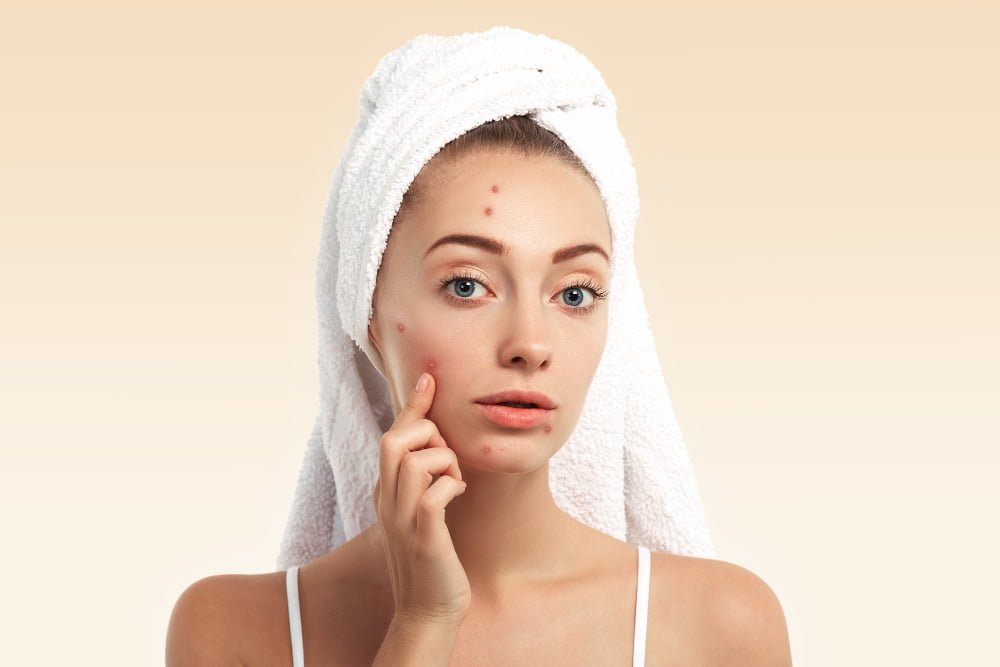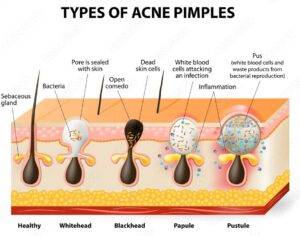- Acne, also known as pimples or zits, is a common skin condition.
- It occurs when the hair follicles on the skin become clogged with oil and dead skin cells, leading to the formation of pimples, blackheads, and whiteheads.
- Acne is most commonly found on the face, but it can also occur on the neck, chest, back, and shoulders.
- Acne can be a frustrating and embarrassing condition, especially for teenagers and young adults.
Causes of Acne
Below are some of the most common causes of Ance
- Hormonal Changes.
- Stress.
- Pollution, humidity, and exposure to UV radiation.
- Poor skincare habits.
- Oily foods, processed food, bread, pasta, and sweets.
- Constipation.
- Propionibacterium acnes (P. acnes) bacterium.
Types and Symptoms of Acne (pimples)
Several types of acne can occur on the skin. The most common types are:
- Whiteheads: Whiteheads are small, white bumps that appear on the skin. They are caused by the build-up of oil and dead skin cells in the pores.
- Blackheads: Blackheads are similar to whiteheads, but they are open and appear black.
- Papules: Papules are small, red bumps that are slightly raised above the skin’s surface. They are caused by inflammation of the hair follicles.
- Nodules: Nodules are large, painful bumps that are deep within the skin.
- Cysts: Cysts are large, painful bumps that are filled with pus.
Treatment option for Acne (pimples)
- Topical Medications: The most common topical medications used to treat acne include Benzoyl peroxide, salicylic acid, and Retinoids. Topical medications are creams, gels, or lotions that are applied directly to the skin.
- Oral Medications: The most common oral medications used to treat acne include antibiotics and isotretinoin.
- Extraction: Extraction is a procedure where a dermatologist uses a tool to extract blackheads and whiteheads from the skin.
- Chemical peels: Chemical peels are a treatment that involves applying a chemical solution to the skin to remove the top layer of dead skin cells.
- Light therapy: Light therapy is a treatment that uses different types of light to treat acne. Blue light therapy kills bacteria and reduces inflammation.
Home remedies for Acne (pimples)
Here are some of the most popular and effective home remedies for acne:
- Tea Tree Oil: Dilute a few drops of tea tree oil with a carrier oil such as coconut oil, and apply it to the affected area with a cotton swab.
- Aloe Vera: Aloe vera can help reduce inflammation and redness caused by acne. Apply fresh aloe vera gel to the affected area and leave it on for 30-45 minutes before rinsing off.
- Apple Cider Vinegar: Dilute apple cider vinegar with water and apply it to the affected area with a cotton ball.
- Turmeric: Mix turmeric with honey to form a paste and apply it to the affected area, leaving it on for 10-15 minutes before rinsing off.
- Witch hazel: Witch hazel has astringent properties that can help reduce the size of pores and prevent acne breakouts. Apply witch hazel to the affected area with a cotton ball.
Ayurveda medicine for Acne (pimples)
- Mahamanjisthadi Kwath: Mahamanjisthadi Kwath is an Ayurvedic herbal formulation that is used to treat a variety of skin conditions, including acne. purify the blood and help to eliminate toxins from the body, which may help to improve the appearance of the skin.
- Arogyavardhini Vati: It has anti-inflammatory, antimicrobial, and detoxifying properties that help to manage acne and other skin conditions and can help to reduce redness, swelling, and irritation associated with acne.
- Sarivaasav: has anti-inflammatory and anti-bacterial properties that can help to reduce acne and prevent new breakouts.
- Kaishore guggul: The primary ingredients of Kaishore Guggulu include Guggulu resin, Triphala, Trikatu, Vidanga, Nimba, Guduchi, and other herbs. These ingredients work together to purify the blood, reduce inflammation, and eliminate toxins from the body.
- Chandanasava: antibacterial, anti-inflammatory, and antioxidant properties that can help to reduce inflammation, fight off infection, and protect the skin from damage.
Foods should be avoided
- Sugar and refined carbohydrates
- Unhealthy fats, such as fried foods and junk food
- Dairy products
- like white bread, potatoes, and sugary drinks, These foods can cause a spike in blood sugar levels.
- Oily foods
Commonly questions are asked
Q1: What causes pimples and acne?
A1: Pimples and acne are mainly caused due to excess oil production, hormonal changes bacteria, and constipation.
Q2: How can I prevent pimples?
A2: To prevent pimples, wash your face regularly, avoid touching your face, use non-comedogenic products, and maintain a healthy diet.
Q3: What’s the best way to get rid of pimples quickly?
A3: For quick relief, apply benzoyl peroxide, salicylic acid, or a spot treatment. Don’t pop pimples; it can make them worse.
Q4: Are there natural remedies for acne?
A4: Yes, try tea tree oil, honey, aloe vera, or green tea. They may help soothe and treat acne.
Q5: Does diet affect acne?
A5: Yes, certain foods like sugary items and dairy may worsen acne in some people. A balanced diet can help.
Q6: How can I treat acne scars?
A6: Treatments like chemical peels, microdermabrasion, or laser therapy can help with acne scars. Consult a dermatologist.
Q7: Is it okay to pop a pimple?
A7: It’s best not to pop pimples as it can lead to infection and scarring. Let them heal naturally.
Q8: Can stress cause acne?
A8: Yes, stress can trigger acne breakouts. Practice stress-reduction techniques like meditation or yoga.
Q9: How to shrink a cystic pimple overnight?
A9: Shrinking a cystic pimple overnight can be challenging because these types of pimples are deep-seated and often require more time to heal.
- You can try to reduce swelling and promote healing, such as Ice Compress and hydrocolloid Bandages, clean the face with normal water benzoyl peroxide or salicylic acid.
Q10: Where does the pus go if you don’t pop a pimple?
A10: If you don’t pop a pimple, the body’s immune system breaks down and absorbs the pus. Debris trapped within the pimple and the pus will be reabsorbed by the body.
Q.11: How do pimple patches work?
A11: To use a pimple patch, make sure your skin is clean and dry. Simply apply the patch directly over the pimple and leave it on for several hours or overnight.
** The information provided in this health article is intended for knowledge and informational purposes only.
** Always consult to physician or other qualified doctor for treatment and medicine.

